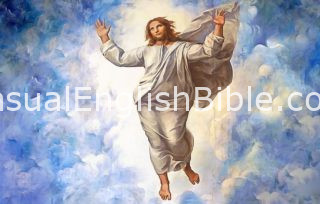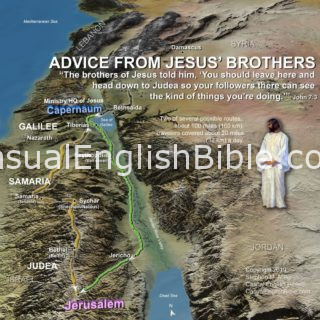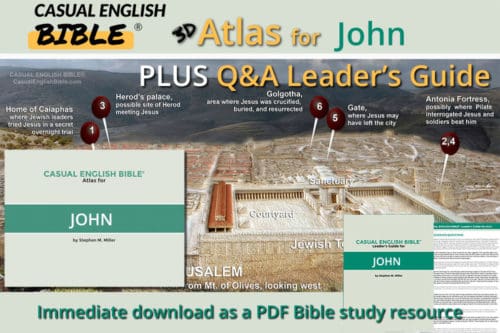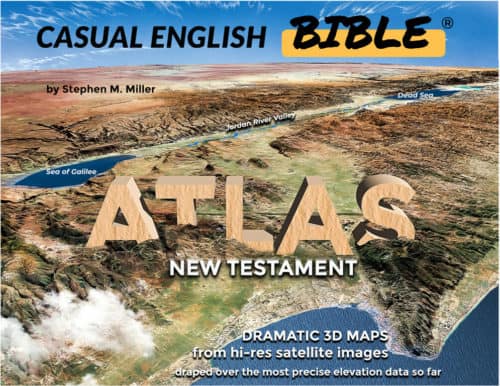
The other three Gospels—Matthew, Mark, and Luke—look so much alike that scholars call them the Synoptic Gospels. That comes from a Greek word meaning “seen together.”
These three Gospels read so much alike, with many of the same stories, that it’s easy to look at them together, comparing them side by side.
No can do with John. This Gospel is its own critter.
Skip the parables of Jesus. John does. Ditto the birth, temptation, baptism, and ascension of Jesus.
Edit out most of the miracles. John reports just seven big ones, which he calls signs—proof that Jesus is the divine Son of God.
John seems to build his Gospel around one idea that he’s trying to convince readers to believe:
“What is recorded in this book is here to help you believe that Jesus is the Messiah, the Son of God—and that by putting your trust in him, you can have a life that never ends” (John 20:31).
There’s one sentence in John that sums up all four Gospels, according to Martin Luther, a Catholic priest in the 1500s who launched the Protestant movement. Luther used this one sentence alongside other Bible passages to help argue that people are saved by faith, not by obeying the pope and other church leaders. This single sentence is one of the most famous quotes of Jesus, and it’s reported only in John:
“God loves the world so much that he sent his only Son here so people could see that he’s real and believe in him. No one who believes in him will die. They’ll live forever” (John 3:16).
Writer
Anonymous, like all four Gospels about Jesus.
The writer does, however, tease us with a clue. He calls himself a “disciple who witnessed all of this and who wrote it down . . . an eyewitness who is telling the truth” (John 21:24).
Though many scholars say more than one person contributed to this Gospel, church leaders from the earliest centuries say the apostle John was the eyewitness source.
John was a fisherman, brother of James, and one of Jesus’s three best friends. James and Peter were the other two best friends of Jesus. They went places with him and saw things the others didn’t. On a mountain, for example, they saw Jesus glow; the event became known as the Transfiguration (Matthew 17:2; Mark 9:2-3; Luke 9:28-36).
Many scholars say the writer identifies himself in humble ways throughout the story, without revealing his name:
- “One disciple Jesus deeply loved was sitting right beside him at the table” (13:23).
- “Jesus saw his mother standing beside the disciple he loved dearly. Jesus told his mother to look at the disciple. ‘Dear woman, look and see your son’” (19:26).
- “The disciple Jesus loved told Peter, ‘It’s the Lord!’” (21:7).
Timeline
John covers the ministry, death, and resurrection of Jesus, from roughly AD 30 to 33. Estimates range from the late AD 20s to the mid-30s. Most Bible experts say the author wrote John sometime near the end of the first century, perhaps in the AD 90s. One clue pointing to this late date: well-developed Christian teachings. The writer seems to have had decades to reflect on the teachings of Jesus and on the meaning behind the miracles he saw with his own eyes.
 Location
Location
John’s stories take place in what is now Israel and in Israeli Occupied Palestinian Territories. Romans named the region Palestine. The word comes from “Philistine,” a warrior race that settled on the coast, around Gaza, and fought the Jews. Jesus ministered in Galilee, a territory in what is now northern Israel. But many stories in John, including the climax—the crucifixion and resurrection of Jesus—take place further south, in Jerusalem.
Intended readers
John’s Gospel reads like an open letter to Christians everywhere. John seems intent on correcting warped teachings about Jesus that crept into the church after most of the disciples and other eyewitnesses to Jesus died. The writer wants to remind readers everywhere that Jesus is the divine Son of God.





